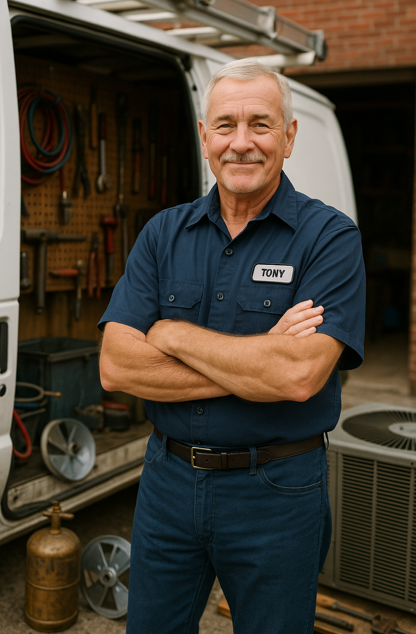Hey everyone, Tony Marino here. Today, we’re going deep on a cooling powerhouse—the 80,000 BTU air conditioner. If you’ve got a large home, commercial space, or a place with challenging cooling needs, an 80,000 BTU AC unit might just be what you’re looking for. In this guide, I’ll cover what this size means, why you might need it, how it works, installation considerations, maintenance tips, and how it stacks up against other systems.
If you’re shopping for smaller spaces, check out the Goodman 3 Ton 14.5 SEER2 R-32 Bundle, which offers reliable efficiency for moderate-sized homes.
What Does 80,000 BTU Mean?
BTU, or British Thermal Unit, is a measure of the amount of heat an air conditioner can remove from a space per hour. One BTU represents the energy needed to raise or lower the temperature of one pound of water by one degree Fahrenheit.
An 80,000 BTU AC unit means it can remove 80,000 BTUs of heat per hour, which is equivalent to roughly 6.7 tons of cooling capacity (since 1 ton = 12,000 BTUs).
That’s a heavy-duty system intended for larger spaces — think commercial buildings, warehouses, or big homes that range from 3,500 to 5,000 square feet, depending on insulation, windows, and climate.
When Do You Need an 80,000 BTU Air Conditioner?
Sizing an AC system isn’t just about square footage. You’ve got to consider:
-
Climate: Hotter, more humid climates need more cooling power.
-
Insulation quality: Poorly insulated buildings lose cooled air faster.
-
Ceiling height: Taller ceilings mean more volume to cool.
-
Number of occupants and heat-producing appliances.
If your home or space has all these factors leaning toward higher heat loads, an 80,000 BTU AC unit can maintain comfort without overworking.
For detailed guidelines on AC sizing, the Department of Energy offers great resources: Energy Saver - Air Conditioning.
Types of 80,000 BTU Air Conditioners
Here are some common types of systems you might find in this size range:
1. Split Systems
These consist of an outdoor condenser/compressor unit paired with an indoor air handler or furnace with evaporator coil.
Pros:
-
Efficient operation
-
Flexible installation
-
Quieter indoors
2. Packaged Units
Everything is in one outdoor cabinet — condenser, compressor, evaporator, and sometimes furnace.
Pros:
-
Saves indoor space
-
Simplified installation
3. Rooftop Units
Common for commercial buildings, these packaged units sit on the roof.
Pros:
-
Frees up ground space
-
Centralized service
Key Benefits of an 80,000 BTU AC Unit
-
Powerful Cooling: Enough capacity to cool large or multi-zone spaces quickly and effectively.
-
Energy Efficiency: Modern units often have high SEER ratings (Seasonal Energy Efficiency Ratio), reducing utility bills despite size.
-
Durability: Designed for heavy-duty use, with components built for longer lifespans.
-
Flexibility: Available in various configurations — split, packaged, rooftop — to fit your specific building needs.
What To Look for When Buying an 80,000 BTU Air Conditioner
1. SEER Rating
Look for a unit with a SEER rating of at least 14 to maximize energy savings. Higher SEERs (16+) are available for premium models.
2. Refrigerant Type
Newer units use environmentally friendlier refrigerants like R-410A or R-32, which have lower global warming potential than older types like R-22.
3. Brand Reputation
Choose brands with a solid reputation and local service networks. Goodman, Carrier, Lennox, and Trane are some top contenders.
4. Warranty
A strong warranty shows confidence from the manufacturer and protects your investment.
For a comparison of top brands, Consumer Reports provides unbiased insights.
Installation Considerations for an 80,000 BTU AC Unit
Due to the size and power demands, professional installation is critical. Here’s what to expect:
-
Electrical System: These units require dedicated 240-volt circuits and possibly electrical panel upgrades.
-
Ductwork: Properly sized ducts ensure balanced airflow and efficiency. Undersized ducts can cause issues like poor cooling or system strain.
-
Space Requirements: Outdoor units need clearance for airflow and service access.
-
Permits: Check local codes for permits or inspections.
For an in-depth installation overview, This Old House offers expert advice.
Maintenance Tips for Longevity and Efficiency
To get the most out of your 80,000 BTU AC system:
-
Change or clean filters every 1–3 months. Dirty filters reduce airflow and increase energy use.
-
Keep outdoor unit clean and clear of debris. Leaves, dirt, and grass can clog coils.
-
Schedule annual professional tune-ups. Technicians will check refrigerant, clean coils, and inspect components.
-
Monitor for unusual noises or drops in cooling performance.
The Energy Star’s Air Conditioner Maintenance Guide is a great resource for homeowners.
Comparing 80,000 BTU Units to Other Sizes
While 80,000 BTU systems serve large spaces, oversizing can waste energy and money. Conversely, undersizing strains your unit and sacrifices comfort.
If your space is smaller, like a typical family home, something like the Goodman 3 ton 14.5 SEER2 R-32 Bundle I mentioned earlier might be the perfect fit. For commercial or extra-large spaces, the 80,000 BTU unit gives you the power you need.
How to Choose the Right Contractor
Working with a qualified HVAC professional is key. Look for:
-
Licensing and insurance
-
Experience with large commercial or residential systems
-
Good reviews and references
-
Willingness to perform Manual J load calculations
Sites like Angi (formerly Angie’s List) can help you find reputable contractors near you.
Final Thoughts From Tony Marino
An 80,000 BTU air conditioner is no small investment — but if you’ve got a big space that needs serious cooling power, it can make a huge difference in comfort and efficiency. Choosing the right system, ensuring professional installation, and staying on top of maintenance will keep your system running strong for years.
If you want advice on sizing or brands, or if you’re considering options like heat pumps or inverter technology, don’t hesitate to reach out. And for smaller spaces, that Goodman 3 ton SEER2 system is a solid starting point.
Stay cool out there!







